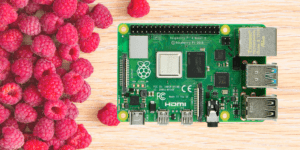Spis treści:
Minicomputers form a broad group of electronic devices and modules used by both hobbyists and professionals to create applications for controlling electronic systems. Minicomputers are found in industrial and home automation systems, household appliances and multimedia devices, among others. In addition, these types of circuits are often used as educational boards for learning programming, electronics, and the operation of the Linux.
There are several basic features of minicomputers. The first and most important is a high degree of integration. This type of modules integrates all elements and functions in one device; on one printed circuit board there are systems responsible for powering all system components: a processor, memory and GPIO circuits, which are also integrated (usually fixed) in one module. As a result, minicomputers do not offer many opportunities to update their parameters; however, they do offer great opportunities for system expansion. Most minicomputers on the market are equipped with a variety of input and output interfaces to which other modules can be connected. There are digital I / O lines and interfaces such as I2C, SPI, UART, I2S and others. In addition, some minicomputers available on the market are equipped with integrated analog-to-digital converters (ADC) and digital-to-analog converters (DAC), which allow you to work with analog signals.
Today, there are many families of minicomputers designed for educational and hobby purposes. However, it was the two lines of modules that popularized such systems and revolutionized the way of learning electronics and programming embedded systems. The two families of modules are Arduino and Raspberry Pi. These systems laid the foundation for a completely new class of devices that was adapted primarily by hobbyists, and created an entire ecosystem of development systems that made it very easy to prototype electronic devices.
Arduino

Based on the work of Hernando Barragán (the creator of the Wiring platform), Massimo Banzi and David Cuartielles developed the Arduino module in 2005. It was intended to be an easy-to-use, programmable device for interactive art projects. The structure was created at the Interaction Design Institute Ivrea in Italy. David Mellis developed the Arduino software based on the Wiring platform. Soon Gianluca Martino and Tom Igoe joined the project, and all five are known as the original founders of Arduino. They wanted a device that was simple to use and configure, easy to connect to various components (such as relays, motors, and sensors), and programmable. It also had to be inexpensive to be accessible to students and artists. They decided to use Atmel’s AVR family of 8-bit microcontrollers and designed an independent open circuit board with easy-to-use connectors, wrote a bootloader for the microcontroller, and turned it all into a simple integrated development environment (IDE) that used programs called “sketches”. The result was Arduino.
Since then, the Arduino ecosystem has evolved in several different directions. Some versions of the modules were smaller than the original, and some were even larger and had more capabilities. Each of them has a specific niche to fill. The common element of all of them is the AVR-GCC library for the Arduino runtime that comes with the Arduino IDE, and a built-in bootloader that comes pre-installed in the microcontroller of each Arduino board. The original family of Arduino modules uses microcontrollers developed by Atmel Corporation of San Jose, California (now acquired by Microchip). Most Arduino designs use the 8-bit AVR microcontrollers, but the Due line is an exception – it has a 32-bit ARM Cortex-M3 core processor. Due’s circuits are radically different from typical AVR devices.
What sets Arduino apart from other development modules using AVR systems is its programming environment and so-called ecosystem. As the makers of Arduino themselves state, the IDE, which is available to all Arduino users, is the cornerstone of the Arduino concept. This environment provides a simple and uniform way for all systems to use modules that are compatible with the Arduino standard. It is a key component of the Arduino ecosystem. The second, no less important element is the community. It consists, on the one hand, of the manufacturers of expansion modules compatible with Arduino, and, on the other hand, of the users of numerous online forums and other places for exchanging ideas, full of people who are ready to help anyone get started in this world, learn how to program, and solve even very advanced problems that may arise when creating your own devices based on Arduino modules.
Raspberry Pi

Raspberry Pi is a compact single-board computer developed in the UK with the original intention of providing a low-cost computing device for educational purposes. However, since its debut, it has grown far beyond this. By default, the Raspberry Pi measures just 85.60mm x 56mm x 21mm and weighs around 50g (exact weight depends on the model). Its small size makes it ideal for embedded systems, home automation devices, gaming machines, or building small clusters of multiple devices.
The origins of this computer go back to the Computer Laboratory at Cambridge University in 2006, when a computer scientist Eben Upton, along with Rob Mullins, Jack Lang and Alan Mycroft, concerned that students coming to study computer science had strayed too far from the technical aspects of computer science, decided to create a simple teaching device to help with learning the basics. This was mainly due to the current school curricula, which primarily emphasized the use of computers rather than understanding how they work.
As a result of this concern, the Raspberry Pi Foundation was formed. Over the next six years, the team worked to develop a low-cost, affordable device that would help schools teach subjects such as programming (especially low-level programming) and electronics. In this way, they wanted to familiarize students with how computers work. The first commercial release of the Raspberry Pi single board computer was in February 2012 and since then the system has undergone a number of changes, there have been many versions and models that differ in processing power, amount of RAM etc. There are also modules from the Zero line – even smaller and cheaper single board computers for the simplest projects.
Arduino clones
The Arduino ecosystem is largely made up of a certain standard dictated by the Arduino IDE on one hand, and by the mechanical format of the first Arduino modules on the other. Many companies produce components compatible with this ecosystem. Thanks to the enormous flexibility of the environment, many modules have emerged; they are usually referred to as Arduino clones. However, they are usually not direct copies of the board – they’re just modules compatible with it. Often, these modules use different microcontrollers and offer significantly more capabilities than the original Arduino module. There are many manufacturers on the market that offer modules that are compatible with the Arduino environment. These are companies like Adafruit, DFRobot, Cytron, Pololu or SparkFun. They produce many modules using microcontrollers from the AVR family, SoC systems with built-in Wi-Fi interface from Espressifa and microcontrollers from the STM32 family with ARM cores.
Modules with Espressifa systems
On the market of modules compatible with the Arduino programming environment, the modules equipped with systems manufactured by Espressifa are very popular. Two systems are mainly used – ESP8266 and ESP32. What distinguishes them from the competition is the integrated complete Wi-Fi wireless communication interface (IEEE802.11), which allows very easy connection of devices with these microcontrollers to the wireless network to exchange data or use REST APIs. Arduino IDE, using appropriate libraries, offers great possibilities in the use of network connectivity. It is possible to implement low-level communication via TCP or UDP or use high-level APIs – as a client and as a server.
The ESP8266 is equipped with an L106 processor – a 32-bit unit based on Tensilica’s standard Xtensa Diamond. The CPU operates at 80 MHz. The ESP32 is equipped with a much more powerful LX6 CPU, which is also based on the Xtensa Diamond chip. In some versions of the ESP32 you can even find dual core systems. This CPU can be clocked at 160 MHz or 240 MHz. These chipsets have RAM integrated RAM, but need an external flash memory to store the program. This memory is connected via the standard QSPI interface.
The systems are equipped with a complete transceiver and a Wi-Fi stack – they are responsible for the physical and software layers. They can work in 802.11 b / g / n networks with WEP, WPA and WPA2. They also have an integrated power amplifier, balun and matching circuit. This eliminates the need for RF components outside the chip. In addition, these systems are equipped with GPIO lines as well as common digital interfaces – SPI, I2C, I2S, UART, and analog-to-digital converters (and digital-to-analog in the case of the ESP32). This gives them the ability to do much more than just control communications via Wi-Fi.
There are many modules that use the Espressifa’s systems described – usually in the form of integrated systems in a module (SoM), such as ESP -WROOM-02 or ESP32-WROOM-32. They have integrated components such as QSPI Flash program memory, Wi-Fi antenna and more. Based on these modules, manufacturers like Adafruit (Feather board line), Cytron (ESPresso and ESPresso Lite board) DFRobot (Beetle, FireBeetle and Bee modules) or SparkFun (Thing and ESP32 Thing modules) offer development boards that are compatible with Arduino IDE and can be connected to Wi-Fi.
Modules with ARM core chips

ARM cores are among the most widely used microcontroller and microprocessor cores in all of electronics. The “big” ARMs are found in smartphones, tablets, and computers, but ARM has also developed a number of smaller cores. Many of them are used in microcontrollers, including Arduino-compatible modules. Nordic Semiconductor systems – nRF52832 and nRF52840 – integrate a microcontroller with an efficient ARM Cortex-M4F core and a Bluetooth transceiver. These systems can be found in the development boards produced by SparkFun. Not only do they offer the capabilities typical for other Arduino boards – GPIO, digital serial interfaces – but they also allow you to build systems that use modern Bluetooth interface capabilities, such as minimal power consumption via Bluetooth Low Energy, ideal for battery applications or Bluetooth Mesh. This allows you to build extensive networks.
Adafruit Feather M0 is a series of Adafruit development boards equipped with ATSAMD21 systems – a compact microcontroller with ARM Cortex-M0 core. It is a general-purpose 32-bit microcontroller that has similar capabilities to the AVR family while offering much more computing power thanks to its 32-bit architecture and a much higher CPU clock frequency. Other boards with ARM Cortex-M0 chips, such as Seeeduino’s LoRaWAN modules, are additionally complemented with modules that enable the use of the LoRa network; this is a long-range, low-speed communication network optimized for low power consumption. It is designed for use in battery-powered Internet-of-Things systems. It is ideal for building distributed sensor networks, logistic systems (e.g. monitoring the position and parameters of vehicles in the city), etc. These modules also ensure compatibility with the Arduino IDE, which simplifies the creation of firmware for them and allows access to standard Arduino libraries and sample sketches prepared in this environment.
Other development boards compatible with the Arduino environment

There are also modules available on the market that use the Arduino IDE to program other microcontrollers. This is possible thanks to the high flexibility of IDE, which allows programming tools to be uploaded for any hardware platform. In this way, it is possible to use the Arduino IDE and in most cases the same program sketches to control different types of modules.
Among the most popular small 8-bit microcontrollers, besides the AVR, is the PIC family (from PIC10 to PIC18). These systems are manufactured by Microchip (the same company that bought Atmel, responsible for the AVR systems). There are a number of development modules for PIC chips on the market that are compatible with and can use the Arduino environment. One example is PIC.duino Net, which uses a special PIC18 microcontroller equipped with a full Ethernet interface so that the system can be connected to the Internet. There are also developer modules for “larger” PICs, i.e. 32-bit PIC32 microcontrollers with MIPS architecture. Microchip has released a number of development modules of this type (e.g. Microchip chipKIT Uno32, Max32 and others).
RISC-V architecture is a novelty on the market of microprocessors and microcontrollers. It is an open source hardware instruction set architecture (ISA) based on the established principles of reduced instruction set architecture (RISC). The project was started in 2010 at the University of California, Berkeley, but many of the contributors are volunteers outside the university. Unlike other academic designs, which are optimized primarily for simplified representations of functional principles, RISC-V designers say their instruction set is suitable for practical use. RISC-V systems feature wide-ranging efficiency in terms of power consumption or computational performance. As of June 2019, version 2.2 of the user-space ISA and version 1.11 of the privileged ISA are frozen to allow software and hardware development. RISC-V was implemented in the form of processors and microcontrollers. The latter have been used in Arduino-compatible modules.

Currently, there are several companies on the market that build structures based on RISC-V. The leading position is currently held by SiFive, which has developed a range of flexible RISC-V microcontroller and microprocessor designs. Based on the SiFive E31 chip, this company created the HiFive1 development module, which has full Arduino IDE support with presets for different processor timings (16/256/320 MHz) and a ported Arduino library, thanks to which it is possible to easily transfer Arduino sketches from other platforms to this module.
Another very interesting module that uses the RISC-V architecture is AI Hat from Grove. On the one hand, it is a HAT for the Raspberry Pi module, on the other – a development board that can work completely independently and is compatible with the Arduino IDE. This circuit is based on the Sipeed MAix M1 module with a Kendryte K210 processor. This is a dual-core, 64-bit RISC-V processor clocked at 400 MHz with an efficient pipelined FPU. The AI Hat module, as the name implies, is intended to work as an AI algorithm accelerator, specifically for machine vision systems for Raspberry Pi single-board computers.
Single-board computers
A single-board computer is a complete computer built on a single printed circuit board with a processor (or ami), memory, input/output (I/O) circuits, and other essential components such as power management subsystems. Single-board computers are most commonly used as demonstration systems or development modules for educational systems or for use as embedded controllers in industrial systems. Many types of home computers or laptops integrate many of their functions on a circuit board, but because not all computer components are integrated on a circuit board, they are not called “single-board” computers.
Unlike desktops, single-board computers often do not use expansion slots to add peripheral functions or expansion modules to the systems. Single-board computers are built with a wide variety of microprocessors. Simple designs used by hobbyists often use static RAM and cheap 8- or 16-bit processors. Blade servers are another type of single-board computer. Individual blades of such a server are complete server computers packed in a compact form.
A special form of single-board computers are the so-called system-on-a-module (SoM) devices. They contain all the computer components on one board, the only difference being that SoMs are designed to be mounted on a carrier, socket, or other dedicated board assembly that is equipped with elements normally missing from the SoM – expansion connectors, additional voltage stabilization systems, etc.
Odroid

Odroid is a family of Hardkernel single-board computers. The name of this family was formed from the words “open” and “android”. While not all of the system’s documentation is open, much of it is indeed open source. It is no coincidence that Android appears in the name: the modules have been optimized for use with this operating system. However, it is also possible to use other operating systems, mainly Linux distributions. An excellent example of an Odroid single-board computer is the C2 model. This device is equipped with a 64-bit processor with four ARM Cortex-A53 cores clocked at 1.5 GHz. The module has 2 GB RAM and a microSD card slot built in. For further expansion, Odroid C2 is equipped with a Gigabit Ethernet port, four USB ports and an HDMI output. This computer has also a 40-pin GPIO connector compatible with the Raspberry Pi standard, thanks to which many HATs can be used with this single-board computer.
Orange Pi
Created by Shenzhen Xunlong Software, Orange Pi is a family of single-board computers designed to compete with the Raspberry Pi. It uses a similar format to the Raspberry, but its modules are not always mechanically compatible with it. What maintains partial compatibility is the 40-pin GPIO connector, which provides the ability to use a large part of the HATs created for this platform.
The latest single board computer in this family – Orange Pi 4B – features an advanced SoC from Rockchip – RK3399, manufactured using 28nm technology. It integrates a fast six-core CPU in the big.LITTLE ARM architecture, consisting of two efficient Cortex-A72 cores and four low-power Cortex-A53 cores. The CPU is fully 64-bit and can be clocked at up to 2 GHz. The SoC also features an integrated GPU (Mali-T864) and a Neural Network Accelerator (SPR2801S) to accelerate artificial intelligence algorithms. The module has up to 4GB of LPDDR4 RAM and 16GB of eMMC flash memory. This computer is also equipped with a fairly standard set of communication ports, such as HDMI, USB and Gigabit Ethernet.
Rock Pi

The Rock Pi single-board computers are one of the most popular PCBs among electronics and robotics today. These modules attempt to be compatible with the Raspberry Pi but have some distinguishing features, such as the use of a more modern Wi-Fi module that provides support for the IEEE 802.11ac standard, support for Bluetooth 5.0, and a Gigabit Ethernet jack with Power-over-Ethernet (PoE) capability that allows the board to be powered through this port, so only one cable is needed to connect this single-board computer to the Internet. Rock Pi 4 uses Rockchip’s six-core chip; similar to the one found on Orange Pi, and has 4GB of LPDDR4 memory. This system, in addition to the possibility of connecting a microSD card, offers the possibility of connecting the eMMC module and SSDs via a special adapter. This module is quite power-consuming, but it can be powered via USB-C, which completes the list of possible power sources thanks to the support of USB-PD and Qualcomm Quick Charge 2.0 / 3.0. The list is also completed by the possibility to power the module from a battery thanks to the built-in converter and JST socket.
Banana Pi
Banana Pi is a line of inexpensive and compact single-board computers manufactured by the Chinese company Shenzhen SINOVOIP. The company itself makes no secret of the fact that the shape of Raspberry Pi computers has a major impact on the Banana Pi project. Banana Pi is compatible with them. In addition to Raspbian, Banana Pi can also run NetBSD, Android, Ubuntu, Debian, Arch Linux operating systems. In newer modules, the company offers Bananian – their own operating system similar to Raspbian.

The latest iteration of the single-board computers in this family – Banana Pi BPI-M4 – uses the efficient Realtek RTD1395 SoC. It features up to 2 GB RAM and 8 GB of built-in eMMC memory, as well as built-in WiFi 802.11 b / g / n / ac and Bluetooth version 4.2. The RTD1395 is equipped with a powerful quad-core processor with ARM Cortex-A53 cores, with built-in 512 KB L2 cache. In addition, the RTD1395 integrates the ARM Mali-470 graphics processor, which enables faster processing of 2D and 3D graphics. What distinguishes Banana Pi computers from Raspberry Pi is the presence of SATA or PCI -E ports (in the form of an M.2 slot). They allow connecting fast hard drives and SSD storage, which makes Banana Pi single-board computers ideal for building efficient and compact NAS servers.
How useful was this post?
Click on a star to rate it!
Average rating 5 / 5. Vote count: 2
No votes so far! Be the first to rate this post.






